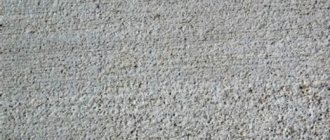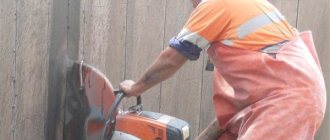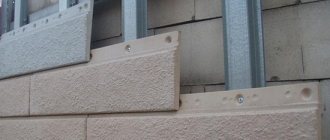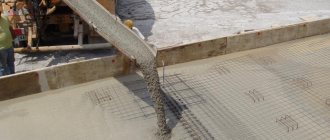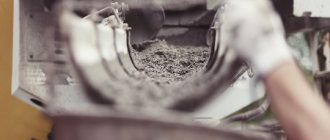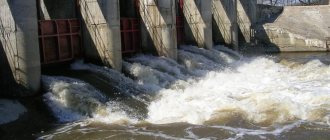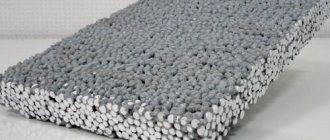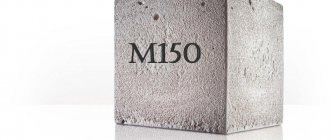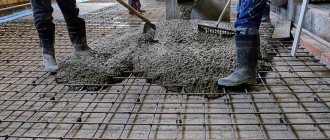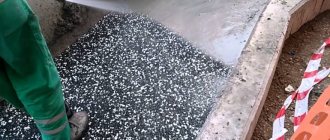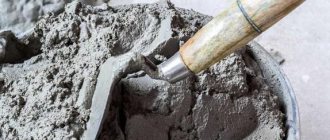The production of concrete work is associated with high labor costs. The concrete itself hardens in a few hours, and gains full design strength after 28 days. The composite concrete substitute from the Hilst company does not have these disadvantages; moreover, when using it, there is no contamination of the concreting area.
Hilst concrete substitute does not require preliminary preparation and hardens extremely quickly
Description and features
The exact chemical composition is a trade secret. The material itself is two-component and is supplied in separate containers. When mixed, a violent chemical reaction occurs, the concrete substitute forms an abundant fine-grained foam, which expands, fills all small holes and hardens.
Use does not require the use of additional materials such as sand, screenings, crushed stone or cement. This alternative to concrete is convenient in cases where it is necessary to carry out small work in remote or hard-to-reach places.
This video demonstrates the work of different brands of concrete substitutes:
Mushroom houses: a sustainable alternative to concrete?
As part of Netherlands Design Week, Company New Heroes and biotech company Krown Design unveiled The Growing Pavilion, built using only materials that grow on the ground, including wood and mycelium.
Mycelium (the root structure of mushrooms) is a natural, processable material. According to Krown Design, to create the building, they filled molds with hemp substrate for further mycelial growth. It took 4 days to fill the mold with mycelium. He then pulled the material out of the mold and dried it in an oven to kill the mycelium. The result is a “strong and lightweight” product that is shock-absorbing, fire-retardant and insulating.
“Social challenges such as climate change, disruption, CO2 emissions and fossil fuel shortages require new, sustainable solutions,” said Diane van Bokhoven, creator of .
Concrete is the most widely used man-made material, but its key component, cement, has a huge impact on the environment. It accounts for 8% of global CO2 emissions. Mycelium, however, helps the environment. As it grows, it captures twice its mass in carbon dioxide.
During Netherlands Design Week, The Growing Pavillion was visited by over 75,000 people, including industry professionals and government officials. According to Diane van Bokhoven, this project is the first step on a long path to changing our environment. She explained: “Right now, good material alone is not enough for large-scale use. We need to think about ramping up production, compliant regulations, innovative designers and conscious consumers.”
“The Growing Pavilion is an ode to the beauty and power of bio-based materials. Most biomaterials are still too often perceived as simply beautiful and environmentally friendly alternatives to traditional materials. We see this as a flaw: why aren't biomaterials seen as better, smarter, more original, healthier and more beautiful alternatives to what we already know? We believe that new designs and applications of these materials are required, as well as their own recognizable and recognized uniqueness,” explain the creators.
“In our Materials Atlas, we share a collection of all the materials found and used in our biotechnology and construction research. In this way, we want to show how far we can currently go in the pursuit of completely biotechnological products. We have met many smart and conscientious industry pioneers who are challenging the world of design and construction to take the next step; they can also be found in this atlas,” says the company’s website, where a collection of their knowledge about biomaterials is publicly available.
“Through The Growing Pavillion and our Content Atlas, we have placed and contributed to this conversation on the global agenda. This is an important step to achieve the desired changes in thinking and action,” said Diane van Bokhoven.
Yana Dotsenko
Source: livekindly
Photo: companynewheroes
Technology of use
Using the Hilst concrete substitute is so easy that anyone can work with it, even those without construction skills. The procedure is as follows:
- a hole is dug in one way or another for a fence post or other structure;
- the concreted element is installed in the design position and temporarily secured;
- in any convenient container, carefully mix the two components of the cement substitute for Hilst pillars;
- the resulting mixture is poured into the well.
Soon foam begins to form, which hardens after 5 minutes. It will take only 2 hours to fully gain strength.
Application
To install a support in the ground, you need to dig a hole slightly larger than the diameter of the pole. A pillar is placed in it and filled with the Hilst solution mixed using a mixer. For proper installation, you need to hold the support in the correct position for 5 minutes. After 60 minutes, the pole is considered securely fixed so that the necessary accessories can be attached to it. When the solution gets into the well, the reaction between the components in the composition begins to occur more violently - the mass hisses and increases in size. This should not be feared, since such “behavior” of a concrete substitute is considered the norm.
When the material begins to “work”, this is noticeable by its visual expansion in volume and hissing.
Application area
This building material is not suitable for massive concreting. Its main purpose is the quick construction of supports for fences or other structures that will not bear a significant load. In terms of its strength characteristics, the concrete substitute is still significantly inferior to it.
Initially, a composite analogue of concrete from the Hilst company was created for quickly and easily strengthening fence posts in the ground. But it is also suitable for working with the following structures:
- supporting elements of road signs, barriers and parking lot dividing posts;
- horizontal pipeline structures that must have reliable support;
- support units for lanterns, gazebos, canopies, etc.
Application of CLT panels
From gluing boards to a finished wood panel house
Factory-made CLT panels allow you to design and build houses of varying complexity; a defective part can be easily replaced. Innovative solutions used in CLT technologies provide:
- High load-bearing capacity, walls can be erected from 90 mm panels;
- Increased fire resistance, in the source of fire the panels do not lose strength for 30 minutes;
- Reduced construction time, house kit with an area of 200 sq. meters is assembled “turnkey” in four days;
- Possibility of using any material for interior and facade decoration;
- Minimizing glue consumption; to make one square, 200 grams of adhesive composition is required;
- Uniform application of improving impregnations over the entire area of the panels.
Advantages and disadvantages
Like any building material, the Hilst composite system for embedding columns has a number of advantages, but is not without its disadvantages. The positive qualities are:
- speed of work;
- there is no contamination in the place where the work is carried out;
- environmental friendliness of the material;
- does not absorb moisture and has neutral acidity, which increases the durability of monolithic wooden structures;
- Can be used in cold weather (down to -25°C);
- dielectric properties provide additional protection for metal posts from the effects of stray currents and subsequent corrosion.
The main disadvantage is the rather high cost. However, this does not seem that significant, since 1 liter of substitute replaces 40 kg of concrete mixture.
Concrete substitute HILST (HILST)
Assortment and price
| HILST Standard Volume: 1 liter (0.5+0.5 l) Filling volume: 14 liters Number of columns: up to 2 Price 750.00 rub. | HILST Professional Volume: 10 liters (5+5l) Filling volume: 140 liters Number of columns: up to 20 Price RUB 6,500.00 | HILST Expert Volume: 40 liters (20+20l) Filling volume: 560 liters Number of columns: up to 70 Price RUB 24,000.00 |
Distinctive features
HILST Standard is a system for private, single use. The density and strength of the composition has an optimal ratio for the installation of ventilated fences, barriers, parking bollards, canopies and pergolas. Supplied in a box containing 2 cans of 0.5 l and 1 l and a total weight of 970 g.
HILST Professional is a system for professional and private use. It is advisable to use for the installation of fences with a length of more than 15 meters, both ventilated and solid, with a height of no more than 2.5 meters and a span width of no more than 2 meters (for ventilated fences, a height of no more than 6 meters and a span width of no more than 2.5 meters). Supplied as a set in 2 canisters of 5 liters each.
HILST Expert – a system for mounting vertical power transmission line supports, industrial antennas, lamp posts, etc. The maximum strength of the composition ensures reliable fixation of such structures. Supplied as a set in buckets of 20 kg of each composition.
Advantages of HILST concrete substitute over concrete
- HILST gains strength in 5 minutes (maximum strength after approximately 1 hour). Concrete at least 24 hours. This significantly reduces installation time.
- Less effort during installation. HILST concrete substitute is required 40 times less (in terms of volume and weight).
- Cheaper and easier delivery to the installation site, especially important for hard-to-reach places (swampy areas, mountains or forests).
- A 2 times smaller hole diameter is required when installing poles. Because It is almost impossible to fill a small hole with a pillar with high-quality concrete.
- There is no dirt left at the installation site after all work is completed.
- Concrete is hygroscopic and absorbs moisture, so wooden and concrete pillars inevitably rot. In addition, concrete is an alkali, which significantly accelerates the process of corrosion and rotting of pillars. The closed porous structure of HILST does not absorb moisture and prevents rotting and corrosion of poles.
- HILST concrete substitute holds the post more firmly than concrete. During the foaming reaction, the HILST system fills ALL available space in the hole, which is impossible to achieve with concrete.
- It is possible to carry out work at negative temperatures down to -25 degrees C.
- The concrete substitute is environmentally friendly and harmless (although the same can be said about concrete).
Find out more from our specialists!
+7 (499) 684-01-21
Main advantages
View gallery
If it is necessary to build fences or install supports, there is a need to firmly fix pipes or poles in the soil. For this purpose, the technology that is most often used to this day is the installation of elements using ordinary concrete. In this case, a hole is dug into which a support is installed, and the resulting hollow space is filled with a sand-cement mixture. This technique has proven itself quite well, but it has many disadvantages, among the main ones is the long period of hardening of the solution. In order to wait for strength, approximately 28 days should pass. Among other things, such work on mixing the sand-cement mixture is labor-intensive and results in a large amount of dirt and dust. In order to mitigate the disadvantages of this method, you should pay attention to a concrete substitute. This system allows you to install support posts and rods in the shortest possible time without unnecessary dust and dirt. As for the strength of the structure, it will be even higher than what can be achieved when using concrete.
Flaws
The cost of concrete should also interest you if you intend to carry out construction work. For a cubic meter of this material you will have to pay 2800 rubles. Before starting manipulations, you can make a comparison, which will allow you to understand which material will be more profitable to use. It is worth remembering that using substitutes can be quite expensive. As practice shows, benefits are observed only when the use of analogues makes it possible to achieve those properties of the concrete mixture that are necessary when carrying out certain work. If you want to use concrete analogues to reduce financial costs, then you shouldn’t count on it too much, since these substances can be compared in cost to cement, and in some cases they are even more expensive, which is not profitable.
Instructions for applying LIQUID RUBBER “PBK HAVEG” to concrete
Instructions for applying LIQUID RUBBER “PBK HAVEG” to old concrete.
It is IMPOSSIBLE to apply PBK HAVEG LIQUID RUBBER directly onto unprepared, crumbling and loose-surfaced concrete!!! Liquid rubber will stick to the peeling concrete and peel off along with it from the solid base of the concrete.
Mandatory preparation required!
It is necessary to clean, gouge (remove by any available means) the flaking, cracked, loose concrete to the base of strong and durable concrete.
Next, you need to level the concrete surface with a thixotropic concrete compound. However, it is not recommended to use a regular dry mixture (it may peel off, especially on a vertical surface). Wait until the concrete hardens completely.
Next, treat the surface with concrete contact.
After the concrete contact has dried, a bitumen primer must be applied.
Then, “PBK HAVEG” LIQUID RUBBER can be applied to the prepared surface in 3 layers with interlayer drying.
Instructions for applying LIQUID RUBBER “PBK HAVEG” to new concrete.
The new concrete screed must be dried as much as possible.
Next, dust the surface and apply concrete contact to it.
After the concrete contact has completely dried, apply a bitumen primer.
Then, “PBK HAVEG” LIQUID RUBBER can be applied to the prepared surface in 3 layers with interlayer drying.
Possible nuances and difficulties when applying PBK HAVEG LIQUID RUBBER to a concrete base.
Liquid rubber should not be placed on concrete:
Perhaps the surface is damp (not dried enough) or not dust-free.
Liquid rubber peels off from concrete:
Liquid rubber has very high adhesion to any surface (sticks tightly). For concrete, adhesion is 1.3 MPa (megapascal). Liquid rubber can only peel off together with the top layer of old, loose concrete from the base of strong concrete. Liquid rubber by itself cannot peel off concrete!
When applied to concrete, liquid rubber bubbles:
The concrete surface is not dry enough. At the moment of applying liquid rubber (i.e. while it has not yet polymerized), a greenhouse effect may occur in the sun. Because The liquid rubber has not yet hardened, and the moisture has nowhere to go when heated by the sun; it turns into steam, rushing upward, which causes the liquid rubber to “bubble.”
Thixotropic repair composition for concrete is a dry mixture based on high-strength cement, mineral filler, and modifying additives. Unlike other cement analogues, the mixture contains reinforcing fiber. When mixed with water, the material forms a high-strength solution that does not shrink. It is effective in repairing and restoring horizontal and vertical surfaces of damaged concrete structures.
Concrete contact is a polymer dispersion with a high alkali resistance. The primer contains quartz sand; its use can significantly increase the adhesion of the treated surface. Acts as additional waterproofing, forming a waterproof film on a primed surface
Characteristics and properties
| Indicator name | Meaning |
| Composition volume | 1l (cans with a capacity of 1l and 0.5l) |
| The volume of the finished mixture in the well after expansion is completed | 14 l |
| Number of wells per 1 liter of mixture* | 2 pcs. |
| Recommended mixing time for components A and B** | 15-30 sec |
| Mixture expansion start time*** | 45 sec |
| Expansion end time*** | up to 3 min |
| Strengthening time up to 80%*** | up to 5 min |
| Duration time up to 100%*** | until 3 o'clock |
| Compressive strength at 10% strain **** | 660 kPa |
| Mass fraction of water, within | 1,4% |
* Approximate calculation. For the following post sizes and hole diameters: post 62mm x 55mm in a hole with a diameter of 100mm and a depth of 1m; post 60mm x 60mm in a hole with a diameter of 100mm and a depth of 1m; post 80mm x 80mm in a hole with a diameter of 100mm and a depth of 1m; post 100mm x 100mm in a hole with a diameter of 150mm and a depth of 1m; a column with a diameter of 76 mm in a hole with a diameter of 100 mm and a depth of m. ** For effective operation of the composition, the recommended temperature of the mixture during mixing and “concreting” HILST should be +15...+28 degrees. *** At temperature of the composition and ambient air +200C. Keep in mind that at higher temperatures of the mixture or air the reaction rate increases, and at lower temperatures it slows down. **** Approximate value for manual shaking at a temperature of +200C for 20 seconds.
Product code 4620769391100
Do you want to reduce the time it takes to install a fence by 2 times? At the same time, spend less physical effort, use a team of workers that is 2 times smaller in number, and ultimately win in price? All this is possible with the help of HILST Professional.
Options and uses of HILST
Road signs and indicators
| Road direction signs | Advertising signs, billboards, pointers | Road signs, traffic lights |
Parking infrastructure
| Parking bollards | Boundary fences in yards | Automatic and manual barriers |
Flagpoles, masts, antennas, wind generators
| Flagpoles | Outdoor antenna masts | Weather stations |
Pillars of different types
| Fences - the most popular application | Garden and park lanterns | Power lines |
Pergolas
| Pergolas for recreation areas | Decorative pergolas | Flower garden pergolas |
Canopies, verandas
| Carports | Canopies for picnics and holidays | Canopies-verandas |
Gazebos and terraces
| Park public gazebos | Garden gazebos | Covered terraces |
The market itself will force us to abandon cement
Cement corporations themselves invest in the development of new materials. Or rather, they are forced by investors: the more environmental damage an industry causes, the less profitable such an asset becomes. That's why the world's fourth largest cement producer has set itself the goal of becoming neutral by 2030. And the main player in the market, LafargeHolcim, not only invested money in Solidia, but also provided its facilities for experiments.
The company managed to produce 10 tons of the mixture and prove that it is possible to set up a new system in existing production facilities. It remains up to the producers of the concrete itself. Two large companies in the United States are already using the technology, and as soon as there are ten of them, the production of environmentally friendly cement without harming the atmosphere can begin on a global scale.
Solidia believes that this transition is only a few years away.
